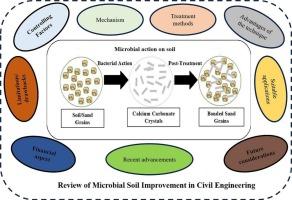微生物在岩土工程应用中改良土壤的最新进展和未来前景:综述
Q1 Environmental Science
引用次数: 0
摘要
微生物诱导碳酸盐沉淀(MICP)是一项前景广阔、适应性强的技术,在岩土工程中应用广泛,可通过利用微生物促进清洁技术的发展。微生物代谢过程是碳酸钙沉淀的介导过程。本文对 MICP 进行了深入研究,深入探讨了其基本机制、关键影响因素和发展前景。文章探讨了影响 MICP 技术的重要因素,如微生物菌株、土壤特性及其几何形状、固结溶液的优化以及周围环境(包括 pH 值和温度)等。本文还介绍了这些微生物菌株在土壤中的各种应用方法,深入探讨了它们在不同土壤和周围条件下的应用过程。本文进一步强调了利用微生物改良土壤的益处,有可能部分或全部取代传统方法。除了其预期用途,本文还探讨了 MICP 的缺点和限制,如微生物的生存能力和碳酸盐沉淀物的长期稳定性。此外,还阐明了利用微生物改善土壤岩土工程的财务影响。该分析非常详细,并就未来可能出现的机遇提供了更多信息。它还有效地突出了目前在 MICP 领域取得的进展,充分发挥了其潜力,并有助于全面了解微生物过程(MICP)在改善岩土工程应用中的作用。本文章由计算机程序翻译,如有差异,请以英文原文为准。

Recent developments and future prospects of micro-organisms in enhancement of soil for geotechnical engineering applications: A review
Microbially Induced Carbonate Precipitation (MICP) is a promising and adaptable technology with numerous applications in geotechnical engineering promoting cleaner technology via the utilization of microbes. Microbial metabolic processes mediate the process resulting in the precipitation of calcium carbonate. The review presented here gives an in-depth examination of MICP, delving into its underlying mechanisms, key influencing factors, and prospects. It addresses the important elements shaping the MICP technique such as microbial strains, soil properties and its geometry, optimization of cementation solution, and the surrounding conditions including pH and temperature, etc. The various application methods of these microbial strains to the soil have been incorporated in this paper offering insights into their application process tailored to different soil and surrounding conditions. The paper further highlights the benefits of utilizing micro-organisms in soil improvement to potentially replace the conventional methods, partially or fully. Along with its intended uses, MICP's drawbacks and restrictions like microbial viability and the carbonate precipitates long-term stability are examined. Additionally, the financial implication of the utilization of micro-organisms in the improvement of geotechnical enhancement of soil has also been shed light upon. The analysis goes into great detail and provides additional information on possible future opportunities. It also effectively highlights current advancements in the field of MICP, harnessing its full potential and contributing toward a wholesome understanding of the microbiological process (MICP) in improving the behaviour of soils for geotechnical applications.
求助全文
通过发布文献求助,成功后即可免费获取论文全文。
去求助
来源期刊

Bioresource Technology Reports
Environmental Science-Environmental Engineering
CiteScore
7.20
自引率
0.00%
发文量
390
审稿时长
28 days
 求助内容:
求助内容: 应助结果提醒方式:
应助结果提醒方式:


